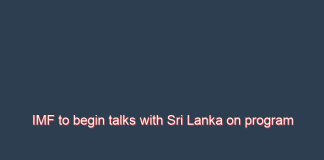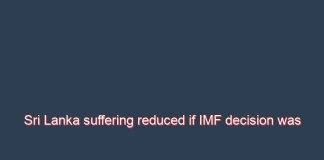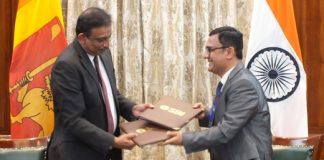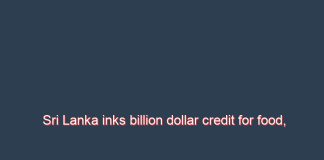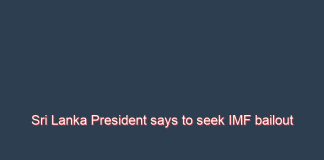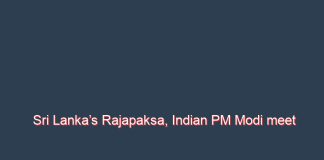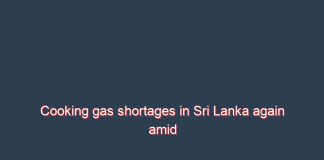Fertilizer Crisis led to Tea Industry fall
IMF to begin talks with Sri Lanka on program
ECONOMYNEXT – The International Monetary Fund intends to begin discussions with Sri Lanka on a program to support the country, spokesman Gerry Rice said as the island is facing steep currency depreciation and inflation after an unusual bout of money printing to keep interest rates low.
President Gotabaya Rajapaksa said in a national address Wednesday said that he had given the go ahead for an IMF program after meeting senior staff of the lender in Colombo.
“The authorities have also indicated that they are actively considering an IMF-supported program,” IMF spokesman Gerry Rice said.
“We will discuss with the authorities how best we can assist Sri Lanka going forward, including during the Minister of Finance’s visit in Washington in April.”
The IMF has already called for for tighter monetary policy to stop liquidity injections which create forex shortages.
Related
Sri Lanka debt unsustainable, should stop printing money, hike rates, taxes: IMF
Sri Lanka President says seeking IMF bailout for forex crisis, debt
Sri Lanka money printing, deficits could lead to economic implosion: IMF report
The IMF has analyzed Sri Lanka’s economy in a staff report which has been submitted to the board, following annual Article IV consultations. The full report has not been made public, but key conclusions, including that the debt is unsustainable is now known.
Urgent Action
The report also warned that the economy could implode unless actions was taken to halt monetary instability, though analysts say the IMF does not make a habit of modelling disaster scenarios.
Rice said the IMF had highlighted “the urgent need of implementing a credible and coherent strategy to restore macroeconomic stability and debt sustainability, while protecting vulnerable groups through strengthened, well-targeted social safety nets.”
With the debt deemed unsustainable, re-structuring or re-profling will also be required.
Sri Lanka for sometime has not had a working exchange rate regime, with a peg having lost credibility and parallel exchange rates emerging due to money printing.
In a program a float of the currency to end dual anchor conflicts (reserves sales for imports and money printing to maintain the policy rate) is a prior action. Though the exchange rate has been allowed to fall, a clean float has not yet been established.
Analysts have said the central bank should to remove a surrender requirement that effectively imposes a strong side convertibility undertaking in the style of a peg and further weakens the rupee.
Further policy rate hikes are also needed to make the float work.
If a float is not established, economic problems that took place at 200 to the US dollar, will continue to take place at a weaker level. The currency can be appreciated if required after domestic credit slows (consumption and investments slows) and sterilizing inflows.
An IMF program typically involves a tight reserve money program to stop inflation and block the validation of domestic prices as the currency weakens.
Tax hikes and spending cuts will reduce the budget deficit and domestic credit, keeping down the corrective interest rate. Sri Lanka’s private citizens are net savers and are incapable of triggering currency pressure.
A foreign reserve target is also given and reserves for imports are generally discouraged (sometimes a so-called disorderly market conditions intervention is allowed which however can undermine the currency unless they are unsterilized).
Debt re-structuring will also reduce the corrective interest rate and the need to immediately deploy more savings for debt repayment and leave space for reasonable growth path.
India is giving a 500 million US dollar credit and a billion dollar credit for food and medicines which can be used to finance the deficit if they are not used for subsidies.
Medicine credits can be used for the health budget directly or cash collected from private sector importers can be used to finance other expenses such as the salary bill, analysts say.
Unemployed graduates had progressively bloated the public sector and have become a key consumer of the productive efforts of society.
Classical economists and analysts have called for reforms to the central bank to outlaw intermediate monetary regimes (flexible exchange rates/soft-pegs) and go for a single anchor regime made up of a fully reserve-backed hard peg or a clean floating regime with a low inflation-driven monetary base and no foreign reserves.
Such a regime will eliminate the need for IMF programs in the future. A hard peg with a low inflating reserve currency in particular will also serve as a hard budget constraint and help social unrest. (Colombo/Mar18/2022)
Sri Lanka suffering reduced if IMF decision was made earlier: Harsha
ECONOMYNEXT – Sri Lanka’s current economic troubles would have been avoided if a decision has been made to approach the International Monetary Fund earlier and authorities cannot disclaim responsibility, opposition legislator Harsha de Silva said.
De Silva said President Rajapaksa in a national address indicated that he will work with the IMF to solve the economic and debt crisis.
“It is a good thing, but the problem is if the problem was anticipated, why the discussions with the IMF was delayed up to now,” de Silva said.
“That this country was heading for a crisis was warned by independent economists about 18 months earlier.
“If the current decision was taken then, people will not suffer as they are doing now.”
Sri Lanka’s rupee has so far fallen from 203 to around 275 after an attempt was made to float the currency and end dual anchor conflicts (a too low policy rate enforced by liquidity injections which made the peg non-credible), but the float has not yet got established.
De Silva was one of the first legislators who wanted the government to re-profile debt (extent maturity) as the central bank started to print money (monetary stimulus) after cutting taxes (fiscal stimulus) based on Cambridge economics/Keynesian style ideology, torpedoing Sri Lanka’s exchange rate peg.
An exchange rate peg with a stable currency (and external anchor for reserve money) is the simplest monetary regime imaginable and has been followed by East Asia during their fastest growth phase and is also followed by Dubai and other GCC countries.
Sri Lanka had such a regime from 1885 to 1950 where foreign reserves of 11 month of imports were collected until a Latin America style soft-peg (a regime with conflicting external and internal anchors) was set up styled on the Argentina central bank of Raul Prebisch in 1950.
Legislators have the power to eliminate the sufferings of the people with one act of parliament which will take away the discretionary independence of the Monetary Board of Sri Lanka to print money under various pretexts based on failed Anglo-American ideology and commit them to a rule of law.
In South Asia itself the Maldives has a partly credible peg which had broken only once or twice while Bhutan and Nepal have pegs with the Indian rupee which have lasted even longer.
However the Indian rupee is not a stable external anchor and its policy errors and inflation de-stabilizes both nations.
Both the public and legislators can take away the ability of the economists to destroy currencies by outlawing discretionary monetary policy.
Options include:
Credible external anchor/East Asia currency board: Exchange rate fixed, short term rates floats, domestic operations curtailed by law, reserve money driven by the balance of payments i.e. the foreign reserves.
Credible domestic anchor: Interest rates are targeted by open market operations. Exchange rate interventions barred, no reserves are collected. The government manages both domestic and foreign debt by buying dollars in the open market.
East Asia currency board plus or a peg with high degree of credibility: Wide policy corridor with two way liquidity auctions. Policy ceiling linked to anchor currency policy rate plus 100bp margin.
May end up collecting un-necessary volumes of foreign reserves (Asian savings glut), and subject to risk from Keynesian/Cambridge economics economists coming into senior positions and changing domestic operations.
Currency board plus with excessive reserves are at risk from the US Treasury for false charges of ‘undervaluing’ and a push by the IMF for flexible inflation targeting, which is also an oxymoron dual anchor conflicting regime which can trigger social unrest and unseat governments. (Colombo/Mar18/2022)
Ministers Rajapaksa, Jaishankar and Sitharaman witness the signing of the USD...
Sri Lanka inks billion dollar credit for food, meds, from State...
ECONOMYNEXT – Sri Lanka had inked a deal with the State Bank of India to get a billion US dollar credit for food and medicine, India’s Finance Ministry said.
Finance Minister Basil Rajapaksa and Treasury Secretary Sajith Attygalle is on a two day visit to India.
Rajapaksa has met Prime Minister Narendra Modi, External Affairs Minister S Jaishankar during thevist.
“India stands with Sri Lanka,” Jaishankar said in a twitter.com message.
“US$ 1 billion credit line signed for supply of essential commodities. Key element of the package of support extended by India.”
Neighborhood first. India stands with Sri Lanka.
US$ 1 billion credit line signed for supply of essential commodities.
Key element of the package of support extended by India. pic.twitter.com/Fbzu5WFE3n
— Dr. S. Jaishankar (@DrSJaishankar) March 17, 2022
Sri Lanka is in a severe currency crisis after printing large volumes of money to keep interest rates down and also sterilize interventions, which had triggered an import boom.
However with the central bank running out of reserves, there has been an attempt to float the rupee. (Colombo/Mar17/2022)
Sri Lanka restaurants to close as gas shortage worsens, jobs at...
ECONOMYNEXT – Sri Lanka’s canteens and restaurants will be force to close from March 17 as cooking gas supplies dry up, threatening the livelihoods of around 500,000 persons, a media report quoting an industry association said.
All Island Canteen Ownders Association Chief Asela Sampath was quoted as saying by Sri Lanka’s Lankadeepa newspaper that canteens and restaurants around the country which provide prepared meals will be forced to shut from March 17.
The restaurants employ around 500,000 persons, Sampath claimed.
Sri Lanka’s private Laugfs Gas stopped supplies sometime ago and state-run Litro is also without supplies as tankers await the release of dollars.
A tanker which used to cost about 3.5 million dollars now costs around 8 million US dollars and the firm is also paying demurrage as ships wait an anchor.
If the forex crisis is not solved canteen workers will take gas tanks and plates and camp out in front of the presidents’ office in Colombo, Sampath was quoted as saying.
Sri Lanka is in a serious balance of payments crisis after printing large volumes of money (monetary stimulus) after cutting taxes (fiscal stimulus) to generate a ‘production economy’.
Sri Lanka has suffered forex shortages ever since a Latin America style central bank was set up by a US money doctor in 1950.
Sri Lanka President addresses nation amid forex crisis – full...
ECONOMYNEXT – Sri Lanka President Gotabaya Rajapaksa addressed the nation on March 16, amid the worst forex crisis triggered by the country’s Latin America style central bank which was set up in 1950.
President Rajapaksa said the country will go for an International Monetary Fund bailout as the country reels from fuel, medicines shortages.
Sri Lanka cut taxes in December 2019 and printed large volumes of money to keep interest rates down, boosting domestic demand and triggering a collapse of a soft-peg with the US dollar.
Sri Lanka joined the IMF on August 29, 1950, a day after creating a Latin America style soft-peg (an unstable intermediate regime) after breaking a Singapore and Hong Kong style currency board that kept the country stable since 1885.
It will be the 17th time the soft-pegged central bank has sought IMF help.
The full statement is reproduced below:
Most Venerable Maha Sangha, Priests of other Religions, Mothers, Fathers, Brothers and Sisters, Dear Children and Friends.
I address you today at a challenging time.
I am well aware of the shortages of essential items and increase in prices. I am also aware of issues such as gas shortage, fuel shortage and power cuts. I am also very sensitive to the many sufferings the people have to experience over the past two months. I know that this situation will continue for reasons beyond our control though we make maximum possible efforts with regard to these situations.
I accept responsibility for the actions I take. Today, I am determined to make tough decisions to find solutions to the inconveniences that the people are experiencing. I have appointed a National Economic Council and an Advisory Committee to assist it. I will constantly monitor whether the decisions I make through this are implemented. Therefore, first of all I request you to have faith in the actions I will take on behalf of the people.
I am well aware of the difficulties faced by the people. I was able to better understand and manage all the difficulties faced by the soldiers who were at the forefront of the war against the brutal terrorism and the innocent civilians who were affected by the war.
Our country is not the only country in the world affected by the prevailing crisis situation. The entire world is engulfed with various hardships. Increasing shipping costs, rising commodity prices and shortages of certain goods caused by the Covid-19 pandemic are all beyond our control. However, we have adopted concessionary initiatives for the benefit of the people.
This crisis was not created by me. When those who contributed to the creation of this crisis are criticizing the government in front of the people today, I am attempting to immediately resolve this crisis and provide relief to the people.
In a crisis situation like this, it is the responsibility of the politicians and intellectuals of a country to collectively find solutions to the issues.
The root cause of current issues is our foreign exchange crisis.
The projected export earnings for this year is USD 12 billion, before the rupee was floated. According to the data of the last two months, we have to bear USD 22 billion as the import cost this year. Accordingly, this will result in a trade deficit of USD 10 billion.
Based on recent data, this year we will receive about USD 3 billion from tourism, as well as export services such as information technology, and USD 2 billion from remittances from expatriate workers. Accordingly, the trade deficit will be USD 5 billion.
Meanwhile, USD 6.9 billion will have to be paid in loan installments and sovereign bonds this year. Then there will be a deficit of USD 11.9 billion.
We expect to generate USD 2.5 billion from other grants and investments. Accordingly, there is a total deficit of USD 9.4 billion in foreign exchange.
However, once the rupee is floated, export earnings are expected to reach USD 13 billion. This will also reduce the cost of imports from USD 22 billion to USD 20 billion. If that happens, the trade deficit could be reduced to USD 7 billion. We should aim for this target.
We can also expect USD 4 billion by providing export services and USD 5 billion in remittances from expatriate workers. Accordingly, our trade deficit will be USD 2.4 billion.
We must take action to fill this deficit and increase our foreign exchange reserves.
To this end, we have initiated discussions with international financial institutions as well as with our friendly countries regarding repayment of our loan installments. The government is in discussions with various parties to implement a new method regarding this which will be beneficial to our country. Yesterday’s discussion with the International Monetary Fund was also held for this purpose.
Through those discussions, we hope to find a way to pay off our annual loan installments, sovereign bonds, and so on. Subsequent to my discussions with the International Monetary Fund, I have decided to work with them after examining the advantages and disadvantages.
Due to some decisions I have taken in the recent past, we were able to control the import expenditure to a great extent. We suspended importing vehicles two years ago because we saw this issue in advance. In addition, we encouraged local industries. We also stopped the importation of many non-essential food items and took steps to cultivate those crops in our own country. Now we can witness the successful results of those initiatives.
The most serious issue we face in controlling the cost of imports is the rapidly rising fuel prices in the world market. Generally, more than 20 percent of our import expenditure is spent on purchasing fuel. In the last few months alone, fuel prices in the world market have more than doubled. This is the reason why the increase in fuel prices in our country was inevitable. Fuel is widely used in our country not only for vehicles but also to generate electricity.
This is why, I constantly took steps to discuss and encourage relevant agencies to use renewable energy sources as much as possible.
Therefore, by limiting the use of fuel and electricity as much as possible, the citizens too can extend their support to the country at this time. I hope that you will understand the responsibility lies with you at this challenging time.
The tourism industry, which was collapsed due to the COVID-19 pandemic, is revving. The last two months have seen a clear increase in tourist arrivals to Sri Lanka.
Also, due to the acceleration of the government’s provision of infrastructure facilities in the IT and telecommunications sectors, the revenue generated through these sectors is increasing.
We are a nation that has experienced many adversities and at the same time conquered those challenges throughout the history. We have faced foreign invasions, great famines, natural disasters and threats of terrorism. The way we dealt with the Covid-19 situation has been praised even by international organizations. However, we all need to understand that we have to face difficulties when implementing solutions for the issues for a certain period of time. Therefore, I urge all of you not to be discouraged but to unite as a nation to overcome this crisis.
You requested me to build a secure, disciplined, and a modern developed country, as well as a better education for your children. Almost two and a half years of my tenure were devoted to protect you and your child from the pandemic. I will dedicate remaining period of my tenure to accomplish those original goals.
I urge the Cabinet, the Parliament and public officials to work together as a team to achieve our desired goal of providing a better country for our children with a great commitment.
I entered into politics on your invitation. All of you have placed an utmost trust in me. I will never betray the trust you have placed in me and protect it with a great commitment.
May the Noble Triple Gem bless you all!
Sri Lanka President says to seek IMF bailout
ECONOMYNEXT – Sri Lanka will seek International Monetary Fund support, President Gotabaya Rajapaksa said as the country reels from foreign exchange shortages due to unusually high levels of money printed to keep interest rates low.
Sri Lanka is facing forex shortages for basic imports as printed money has pushed up domestic demand and made it difficult to repay debt.
“To this end, we have initiated discussions with international financial institutions as well as with our friendly countries regarding repayment of our loan installments,” President Rajapaksa said.
“The government is in discussions with various parties to implement a new method regarding this which will be beneficial to our country.
“Yesterday’s discussion with the International Monetary Fund was also held for this purpose.
“Through those discussions, we hope to find a way to pay off our annual loan installments, sovereign bonds, and so on.
“Subsequent to my discussions with the International Monetary Fund, I have decided to work with them after examining the advantages and disadvantages.
Sri Lanka will be seeking IMF help for the 17th time since a Latin America style central bank was set up in 1950 abolishing a Singapore, Malaysia and Hong Kong style currency board that had kept the country stable since 1885.
The Singapore and Malaysia currency board (Straits dollar) was set up in 1898, but the monetary arrangements were retained after independence.
President Rajapaksa meanwhile promised to solve the economic crisis.
“I accept responsibility for the actions I take,” President Rajapaksa said. “Today, I am determined to make tough decisions to find solutions to the inconveniences that the people are experiencing.
“I have appointed a National Economic Council and an Advisory Committee to assist it. I will constantly monitor whether the decisions I make through this are implemented. Therefore, first of all I request you to have faith in the actions I will take on behalf of the people.”
Sri Lanka’s Rajapaksa, Indian PM Modi meet ahead of USD 1...
ECONOMYNEXT – Indian Prime Minister Narendra Modi met Sri Lankan Finance Minister Basil Rajapaksa on Wednesday (16) as the island nation is in the process to finalise one billion credit line deal with India amid worsening economic crisis.
Sri Lanka is facing an increasing risk of sovereign debt default as it has to pay over 4 billion US dollars for foreign loans in 2022 where as it only had 2.31 billion US dollars in its reserves by end February.
India has agreed to provide 1.9 billion US dollars including 1 billion for imports of essential commodities, 500 million US dollars for fuel import and another 400 million US dollars as a swap.
Sources close to the government said Finance Minister Basil Rajapaksa briefed the current economic challenges faced by Sri Lanka and steps it has taken.
The one billion US dollar credit line is expected to be signed during Rajapaksa’s visit, which was postponed twice.
Before meeting Modi, Rajapaksa also met Indian Minister of Foreign Affairs, Shri Harsh V. Shringla.
Before India granted its financial aids, Sri Lanka had to finalise long dragged deals including oil tanks and power projects in Sri Lanka’s eastern district of Trinc0malee where the one of the World’s best natural harbour is located.
India has strategic interests in the Sri Lanka’s eastern Trincomalee since later 1970s.
Diplomats say Sri Lanka is seen getting close to India and the West because it is facing a financial and debt crisis.
The island nation has been an strong ally of China, its largest lender after the end of a 26-year war in 2009.
Government sources have said Indian has asked Sri Lanka to look into longer term solutions for its debt and economic crisis. This includes seeking the International Monetary Fund assistance for debt restructuring. (Colombo/March 16/2022)
Cooking gas shortages in Sri Lanka again amid worsening dollar crisis
ECONOMYNEXT – Sri Lanka’s liquid petroleum (LP) gas suppliers complain of another cooking gas shortage in the market as the gas duopoly is unable to open letters of credit (LCs) due to a prevailing foreign exchange crisis.
Officials of the two gas companies, the privately owned Laugfs and state-run Litro, confirmed the shortage, adding that they are still not able to open LCs even after the country floated the rupee.
“When I called the gas company they didn’t even accept my order,” Premachandra, a Litro gas dealer based in Kalutara told EconomyNext.
Premachandra said he gets his supply every Tuesday and Friday and that it finishes “then and there” but now he doesn’t have any stock left.
Another Litro Gas dealer in Bentota said: “There is a new scam with the gas transporters. They see the queues outside the shop and sell our consignment in front of us from their lorry and do not deliver the goods after the order is made. It’s a loss for us. We have spent so much just to have empty cylinders in our store.”
Gas companies in the country have been complaining about local banks not opening LCs to clear gas shipments.
Sri Lanka’s private gas supplier Laugfs Gas controls around 20 percent of the LP gas market while the state-owned Litro supplies 80 percent.
Laugfs said it needs on average 15-30 million US dollars per month to import gas. (Colombo/Mar16/2022)

